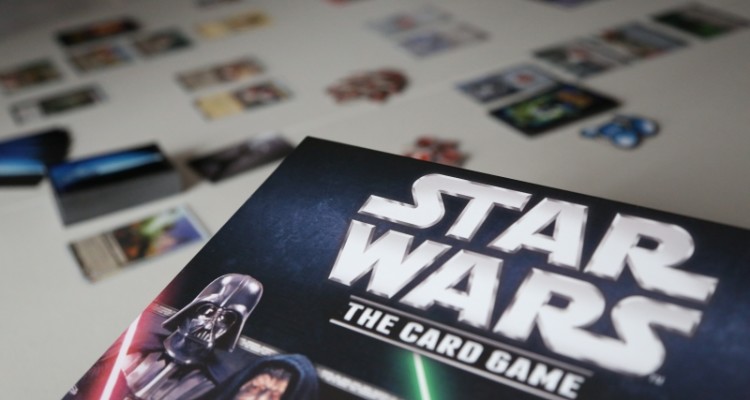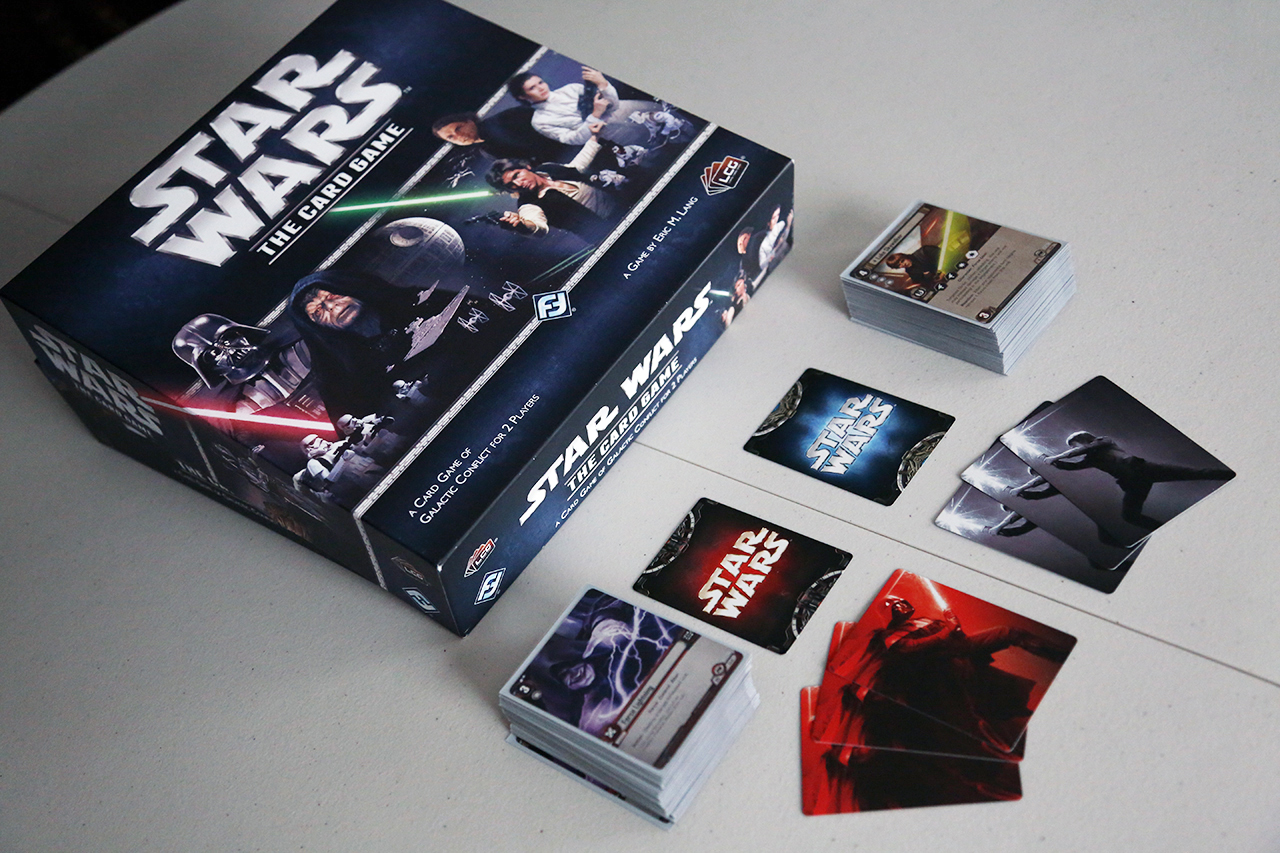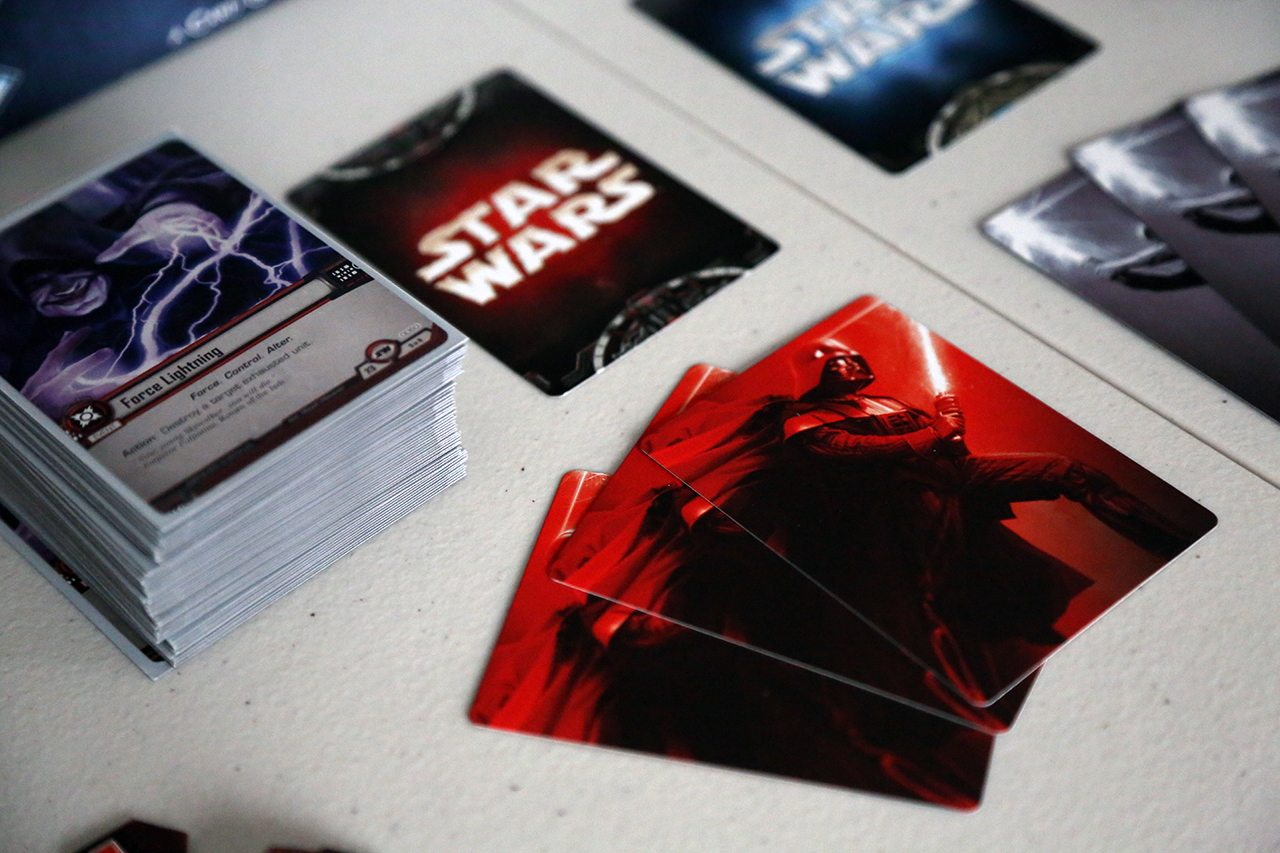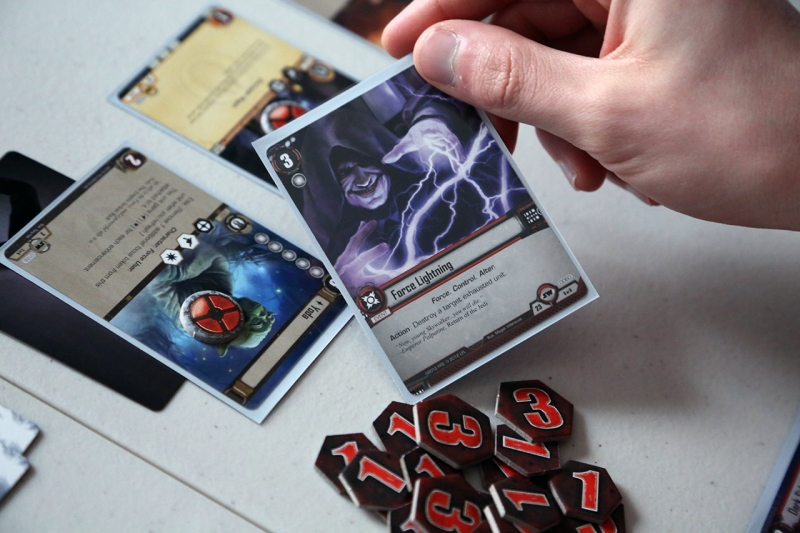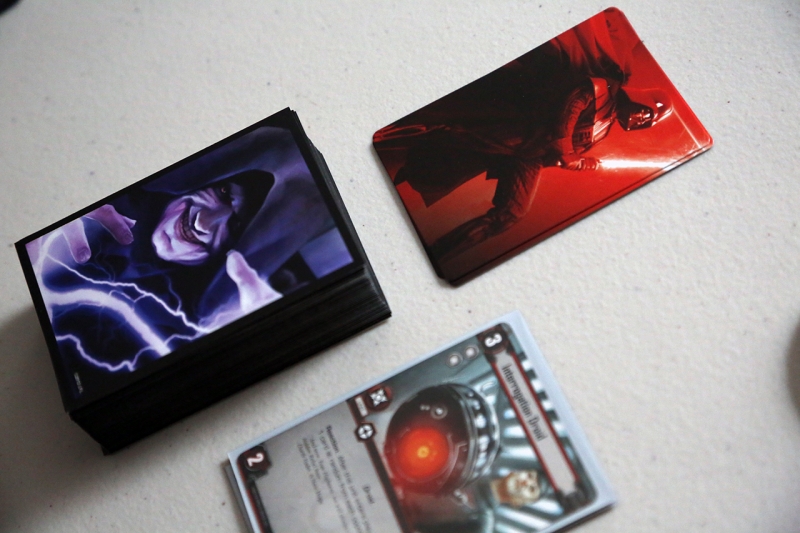INTRODUCTION
I n a game room not too far away, the Rebel Alliance fights a fierce battle against Emperor Palpatine and his sinister Galactic Empire. The Death Star is about to reach its final stage before the rebels face total annihilation. Can the Rebellion mount enough of an offensive to disrupt these plans, or will the Dark Side solidify control of the galaxy?
DESIGN
Star Wars: The Card Game (SW: TCG) is the third in a line of card games set in this universe. The first, Star Wars: Customizable Card Game, was published by Decipher Inc. in 1995. Decipher ended production of their Star Wars: Customizable Card Game after losing the Star Wars license in 2001 and it was then given to Wizards of the Coast, who released Star Wars: Trading Card Game in 2002. Fantasy Flight Games (FFG) came to acquire the license in 2012, after Wizards allowed their control of it to expire. This gave birth to Star Wars: The Card Game, under designer Eric Lang. Did you get all o’ that?
Star Wars: The Card Game is a 2-player (now with a multiplayer expansion), match-style Living Card Game (LCG) from Fantasy Flight Games. Similar to their other LCGs, Star Wars features completely unique mechanics and card design. Players will take on one side of the Force, with each having it’s own win condition. The Dark Side will work to advance their “Death Star Dial” to 12, signaling the completion of the weapon and victory for the Empire, while the Light Side will attempt to stop this by destroying three Dark Side “objectives” before the dial strikes 12.
The core set of the SW: TCG includes 240 cards, which are combined in groups of 6 cards called “objective sets.” Each objective set is comprised of 1 objective card and 5 command cards dedicated to that specific objective. The command cards can either be a unit, an enhancement that can affect a unit, a resource (the in-game currency) providing location, or a one-time event. While some of these command cards may show up in other objective sets, each card has a unique ID number at the bottom that ties the card to that specific objective. To build your player deck, 10 (minimum) of these objective sets will be combined. Which objective sets to choose is generally dictated by your individual play style and the affiliation that you choose. In the core set, you receive 19 objective sets for each side of the Force. Each side of the force has three affiliations within it. The card breakdown can be seen below.
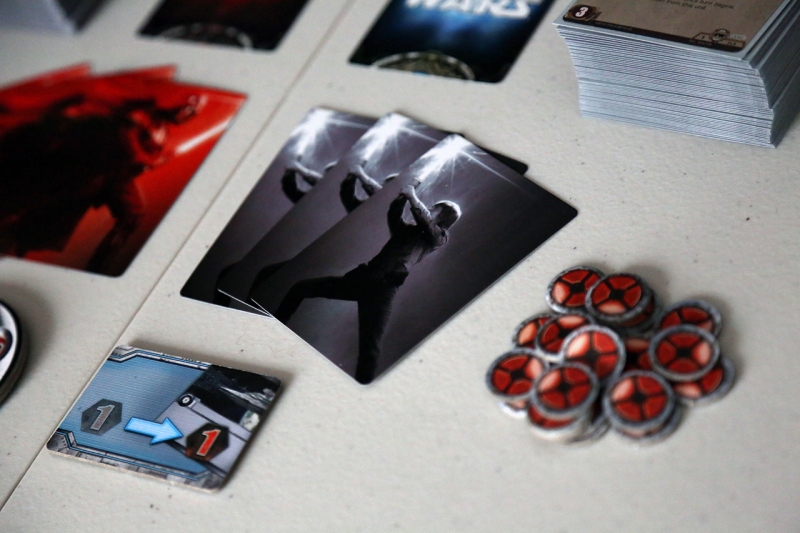 The Light Side is composed of:
The Light Side is composed of:
- 7 Jedi faction objective sets
- 7 Rebel Alliance faction objective sets
- 1 Smugglers and Spies faction objective set
- 4 Neutral objective set
- 1 Affiliation card for each faction
- 3 Light Side Force cards
- 7 Sith faction objective sets
- 7 Imperial Navy faction objective sets
- 1 Scum and Villainy faction objective set
- 4 Neutral objective sets
- 1 Affiliation card for each faction
- 3 Dark Side Force cards
The remaining components include the Death Star dial, a 2-sided balance of the Force token, and damage, shield, and Focus tokens. All of these tokens are made of thick, durable cardboard, as is the norm for FFG. Even so, those looking for a little extra flash can look to the FFG licensed cards sleeves or the Team Covenant Force tokens.
GAMEPLAY
The game setup begins with one player choosing to act as the Light Side and the other the Dark Side. Players then choose a deck to use for the chosen side of the force. This can be one of the pre-made decks right from the box, or one pre-built with hours and hours of blood poured into the creation of a masterpiece (at least that’s what I like to think). After constructing the deck, 1 objective card from each objective set is separated and these are combined to form the “objective deck.” The remaining cards (the other 5 from each group) are combined to form the “player deck.” Then, place all the tokens into an easy to reach spot, set the “balance of the force” to the light side, and the death star dial to zero. Once everything is set up, shuffle and deal 4 objective cards to yourself and select 3 to keep; these are placed face-up on one side of your player area. Each player then draws their starting hand equal to the reserve value of their chosen faction (typically 6 cards). You are ready to begin.
Each player’s turn is composed of 6 phases:
Balance
The Balance Phase varies slightly depending on which player’s turn it is. When it is the Dark Side’s turn, the Death Star dial is increased by one. If the Balance of the Force is with the Dark Side, the Death Star dial is increased by one more. On the Light Side if the Balance is with the Light Side, the Light Side player will deal one damage to any Dark Side objective. Don’t worry, I’ll explain how you get the Balance of the Force onto your side soon.
Refresh
The Refresh Phase begins by removing one focus token from each card in their play area.
Next, shield tokens are removed from all cards in play. Finally, if the player has less than three objective cards in play, they replace the missing objective with the top card of their objective deck.
Draw
At the start of the Draw Phase, the player may discard one card from their hand, if they wish. Then, draw up or discard down to your “reserve value” (which is usually 6). This is a mechanic that cannot be overlooked. I have found that you do not want to try to save cards in hopes of maybe being able to use them later. Because of the objective set system, there will be cards that you don’t care for, that are less important, or may only work in certain situations. Therefore, discarding cards is a way to increase your chances of seeing the cards that you want to see. You may also have a card early on that you wouldn’t be able to use until late game because of the amount of resources required. This type of card would end up wasting valuable space in your hand.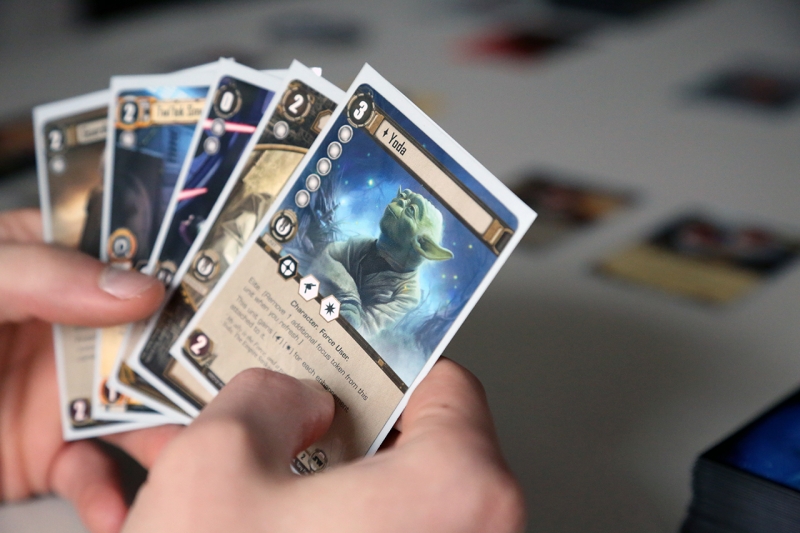
Deployment
Now the Deployment Phase starts. During this phase, cards can be put into play from the player’s hand, paying the appropriate resource cost. To do so, an appropriate amount of focus tokens are placed on resource generating cards, which include all objective cards and some cards played from the player’s hand. If the card being put into play has an affiliation associated with it, one of the resources must be from that affiliation (this is called “resource match”). Any amount of cards can be played during this phase, as long as the resource cost is met. Unit cards are played directly into the play area, while enhancement cards are attached to a given card. There are also event cards which can be played at pretty much any time (well, technically they can only be played during an “action window,” but the rulebook has a chart that explains this much better than I can, here).
Conflict
After all desired cards are deployed, the Conflict Phase can begin. The is the phase where the players can attempt to destroy each others’ objectives. Each objective can be “engaged” once per turn with as many unit cards as the player wishes (Note: you are not required to attack an objective and may choose to do nothing during this phase). After the active player declares which units will attack and which objective they will target, the other player has an opportunity to declare defenders. Any card with a health value (in the bottom left corner) may be declared as an attacker or defender. If both players contribute units to the fight, an “edge battle” occurs, which is a mini-game that decides who will be able to strike first in the actual engagement.
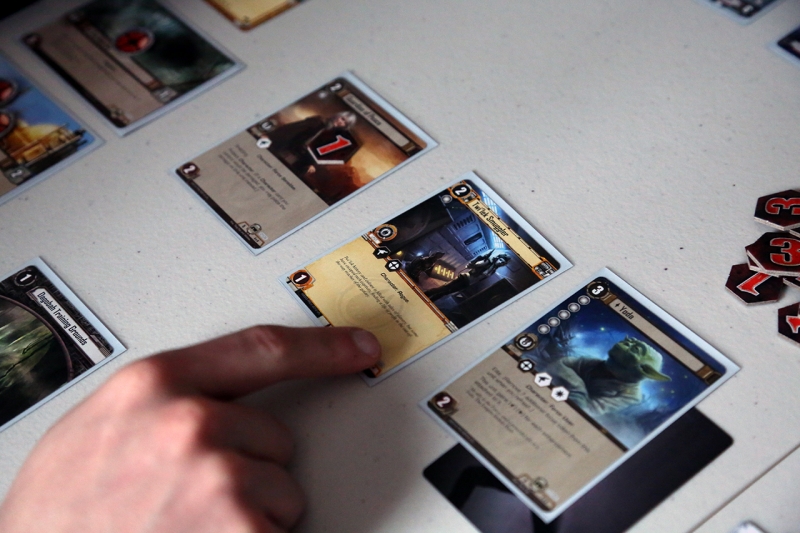 In an Edge Battle, players alternate playing cards from their hand face down until both players pass. The cards are then revealed and the total number of force icons (the circles/bubbles in the top left) on all cards is counted. The player with the most icons “has the edge” and strikes first. This player chooses one unit to activate, resolves all actions, then the other player has a chance to activate a unit. Cards are activated in this alternating player fashion until all units have been activated.
In an Edge Battle, players alternate playing cards from their hand face down until both players pass. The cards are then revealed and the total number of force icons (the circles/bubbles in the top left) on all cards is counted. The player with the most icons “has the edge” and strikes first. This player chooses one unit to activate, resolves all actions, then the other player has a chance to activate a unit. Cards are activated in this alternating player fashion until all units have been activated.
Unit cards have various icons on them that allow them to deal damage directly to units and objectives, or allow them to add a focus token to a card in play (generally your opponent’s cards). Once a card has been used it must have a focus token placed on it – it must “be focused” – and cannot be activated again until the focus token is removed, which occurs during the refresh phase. As you can see, winning the edge battle can be important, as is deciding the order in which to activate your units.
If the Light Side destroys an objective, they set it to the side to keep track of the total number of objectives they have destroyed. However, if it was the Dark Side who destroyed an objective, they get to increase the Death Star dial by one for the total number of objectives they have destroyed, including this one (the first destroyed objective increase it by 1, the second by 2, and so on).
Force
The final phase is the Force Phase. The first step of this phase allows the active player to commit any of his/her units to the force. To do this, a Force card is placed underneath the unit (see phot). Each player only has three Force cards to use at any given time. When committed to the force, the unit must now receive 2 focus tokens anytime it enters battle as an attacker or defender. Once a unit is committed to the force, it can take part in the second step of this phase, the Force Struggle. During the Force Struggle, each player totals the number of Force icons (the same bubbles/circles used for the Edge Battle) on their units committed to the force. However, for the Force icons to count towards the Struggle, the unit committed to the Force cannot have any focus tokens on it. The player with the most Force icons flips the Balance of the Force to their side. On their turn, a player can perform the actions described earlier (+1 to the Death Star Dial or 1 Damage to an objective) if they hold the force.
Winning
The game ends when a victory condition is met for either side. Either side wins if their opponent must draw a card from either their objective or command decks, but cannot. The Light Side wins if they destroy a third Dark Side objective. The Dark Side wins if the Death Star dial reaches 12. Games can either be played as one-offs or as a match, where each player would play both sides. Specific rules for determining match winners and tie-breakers can be found here.
OVERALL EXPERIENCE
Rules
If you are a more visual person like myself, you will appreciate the video tutorial FFG created for this game. It doesn’t go into a lot of detail, but after reading this and watching the video, the details in the rulebook will make more sense. It can take some time to remember all the various action windows. I do still find myself referencing the chart in the rulebook that explains when I have an action window.
Strategy
There are a lot of finer details that you will come across as you play this game. The strategy can change completely depending on what deck each of you are playing. The factions are what the deck building is centered around. Typically you will end up with 2 factions in a deck, even though it is possible to build one with just a single faction. Each faction tends to revolve around a specific strategy. Jedi and Sith factions try to win over the long-term and attempt to control their opponent. Rebel Alliance and Imperial Navy factions opt for a faster paced game utilizing heavy-hitters. They try to accumulate a lot of damage quickly. Finally, we are left with the Smugglers and Spies and Scum and Villainy factions. The style of these two factions is a little difficult to describe, but I would consider them a well-rounded version of their other two counterparts. Aso, Scum and Villainy adds in a capturing mechanic, with the Smugglers and Spies provide a card that can rescue captured units. You can mix and match different objective sets from these factions to create a specific strategy geared towards your desired playing style. One limitation that will shape your decks is resources. When playing cards that have a specific affiliation, one of the resources you use must be from the same affiliation. Therefore, selecting your affiliation card is important. If you created a deck with 8 Jedi objective sets and only 2 Rebel sets, you are going to want to give your deck the Rebel affiliation. This guarantees you one Rebel resource from your affiliation card in the inevitable event that all of your objectives in play are Jedi.
Replayability
There is an entire line up of expansion packs (Force Packs). The Hoth Cycle was released last year, with one Force pack each month for 6 months. Last year also saw the release of two deluxe expansions, Edge of Darkness and Balance of the Force, with the latter introducing game modes that allow for more than 2 players. The Echoes of the Force cycle is planned for release this year. The only expansion I have had a chance to play with is the Edge of Darkness deluxe expansion, but between that and various media outlets, I know that with each new expansion pack the strategy of the game can change dramatically and new cards can make decks much stronger. This game is constantly evolving.
LEAGUE RULING
Ben
This is the first, and so far only, LCG I have become hooked on. It sucked me in from the very beginning and early on I was constantly building and re-building decks and thinking about how cards can work together. This is also the first game that I actually treasured enough to sleeve, and using FFG’s art sleeves adds that much more. I love the asynchronous nature of the game, which essentially allows for 2 games in 1. However, the core set does provide for a limited experience and, while it is playable from a single set, you won’t reach the true depths of this game until you purchase an additional core set. Besides this, the game is genuinely fun to play and well worth the investment. If you have enjoyed card games in the past, I consider this a must have, especially for Star Wars fans.
Buns
If you’ve read my Android: Netrunner review, you may know that A:NR is my LCG of choice. Even with that, I still have a lot of love for Star Wars: The Card Game. While this game plays a little more traditionally, by my standards, in terms of two-players battling it out with attackers and defenders, there are still a number of unique mechanics that really set this game apart.
The resource system is a direct replacement for an in-game currency or “exhaustion system” that allows you to play and use different cards. While it in itself is modestly innovative, it’s the ability to manipulate this, through the “focus” ability of certain units, that is really of note. It adds a layer of depth to the game that allows you to control the field without having to be in direct conflict with your opponent. The fact that “force users” are typically the ones with this ability also adds a nice thematic touch.
The “objective set” system is another way in which FFG’s game looks to transform modern card-games. Rather than having complete freedom to build a deck, you are require to navigate the hardships of combining card groups into a cohesive set. This makes deck-building a task in cost-effectiveness. Sure, you can add that one killer card to your deck, but, when it’s joined by 4 mediocre or even plain bad cards – is it worth it? The system forces you to make these decisions and makes the game much more about creatively maximizing what you have to work with, rather than simply throwing in every good card that’s available.
And finally, of particular note: the Edge Battle. Edges Battles are kind of weird; to a new player they are either treated as something totally worthless or something you have to win every time. With more experience, you begin to learn that neither case is correct and that knowing when (and when not) to fight hard for an Edge Battle can make or break a game. This mechanic also makes the information in your opponent’s hand even more valuable, as those cards serve a purpose outside of being played into the play area.
The game is a blast to play, but it is not without its pitfalls. Out of the box, the game is not remotely balanced, as the Dark Side is particularly powerful with an experienced player at the helm. When evenly matched, the game still remains extremely swingy with large, one-turn, game winning combos floating around. These aren’t the norm, but be sure not to get too comfortable while in the lead – it’s easy to lose hold of.Also, the game is a bit of a beast to learn. There are an inordinate number of symbols found on a single card, with key-words and timing structures that can be difficult to keep track of. This is likely the norm for most card games you may play, but it’s worth noting that it still holds true for this game. Finally, regarding problems, you are only provided with cards for four of the primary factions, leaving you with two unplayable affiliations. This is also coupled with the standard of FFG LCGs – you need two Core Sets to have a full set of cards (or in this case, a full set of 4 out of 6 factions). This game, more-so than others I’ve played, desperately needs a full set of cards to realize its full potential.
All that aside, this is a fantastic implementation of a Star Wars themed card game, mainly because it’s legitimately fun. I love delving into the universe through this card game and derive a lot of enjoyment from both 1) attempting to master the deck-building and 2) attempting to master the gameplay. If you enjoy Star Wars, are willing to pay upfront for two Core Sets, and are prepared for working through the rulebook, this game will really provide something special.
Image Gallery

